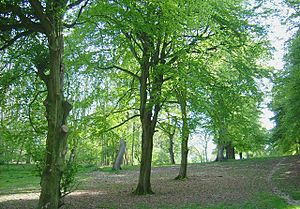Wychwood facts for kids
| Site of Special Scientific Interest | |
 |
|
| Area of Search | Oxfordshire |
|---|---|
| Interest | Biological |
| Area | 501.7 hectares (1,240 acres) |
| Notification | 1988 |
| Location map | Magic Map |
Wychwood or Wychwood Forest is a special natural area in Oxfordshire, England. It covers about 501.7-hectare (1,240-acre) and is protected as a Site of Special Scientific Interest. This means it's important for its plants, animals, or geology. Part of Wychwood is also a National Nature Reserve, which gives it even more protection.
Long ago, Wychwood Forest was much bigger. Over time, people cleared parts of it for farms, villages, and towns. But the forest has changed size many times. For example, some areas cleared during Roman times later grew back into forest.
Contents
What's in a Name?
The name Wychwood comes from an old English word, Huiccewudu. This means 'wood of the Hwicce tribe'. The Hwicce were an Anglo-Saxon group who lived in this area from the 500s. They became part of the larger Middle English society later on.
Villages of Wychwood
Three villages near the forest get their names from Wychwood: Milton-under-Wychwood, Shipton-under-Wychwood, and Ascott-under-Wychwood. People often call them "The Wychwoods." These villages used to be part of the Royal Forest of Wychwood. This meant the king owned the hunting rights there.
A Look Back in Time
Wychwood has a long and interesting history.
Ancient Times
- People lived in the Wychwood area at least 5,000 years ago. Evidence like long barrows (ancient burial mounds) and Bronze Age round barrows show this.
- Between 500 BC and 40 AD, people started to organize more. They built large earthworks like Knollbury Camp and Grim's Ditch.
- During Roman times, roads crossed the region, including Akeman Street. Remains of Roman villas have been found nearby.
- After the Romans left, much of the open land turned back into woodland. Early Saxon settlements were mostly on the edge of the forest or in big clearings.
Royal Forest Days
- Around 978-1016, a royal hunting lodge was built at Woodstock.
- The Domesday Book of 1086 mentioned Wychwood. The king had hunting rights over the whole area, even if others owned the land. Only some parts, like Woodstock and Cornbury, belonged directly to the king.
- By 1300, Wychwood was split into three main parts.
- In 1704, Woodstock Park was given to the Duke of Marlborough.
- In the late 1700s, the navy needed trees from Wychwood for ships. But a report found that the forest was not well cared for.
Changes in the 1800s
- In 1857, a law ended Wychwood's status as a Royal Forest. Old forest rights for local people were stopped, and they were paid for their loss.
- Within two years, about 2,000 acres of woodland became farmland and housing. New roads and seven new farms were built.
- The village of Leafield and its church were built around this time. The remaining woodland was fenced off in 1867 and still exists today.
Forest Keepers
When Wychwood was a Royal Forest, kings trusted loyal people to manage it. These managers were called Foresters of Wychwood, and later, Keepers. Their job was to provide the king with deer, wood, and charcoal. They also made sure the king's laws were followed, with help from other foresters.
The Foresters could even hold court and judge people who broke forest laws. The de Langley family held this job until 1361. After them, the Earls of Warwick were in charge until 1499. Later, kings gave the job to important people as a special favor.
Wychwood Today
Some land that was cleared for farming has been bought by the Woodland Trust. They have replanted it with native deciduous trees, creating new woodlands like Shillbrook Wood and Eynsham Wood.
Since the late 1990s, people have become more interested in Wychwood's history. The Wychwood Project was started to help with this.
Wychwood Forest Fairs
Since 2000, "Forest Fairs" have been held in the old Wychwood area. These fairs are a modern version of older, rowdier fairs that were stopped in 1856. Today's fairs focus on local communities and traditional crafts. Many people visit them, even in bad weather.
Wychwood Warriors
The Oxford University Historical Re-Enactment Society is also known as the Wychwood Warriors. This group acts out parts of Saxon life in Wychwood during the Dark Ages.
Fragments of the old forest still exist. One part on the Cornbury Estate near Charlbury is still called 'Wychwood'.
Wychwood in Art and Stories
Wychwood Forest has inspired many artists and writers.
Paintings
- By Newell Plain, Wychwood Forest, Oxfordshire by William Bowley (1789-1861)
- Duck Shooting in Cornbury Park, Wychwood Forest, Oxfordshire by William Bowley (1789-1861)
- Barking Timber in Wychwood Forest, Oxfordshire by Joshua Cristall (1768-1847)
- Wychwood Forest, Oxfordshire by William Turner (1789-1862)
- In the Forest of Wychwood by Joseph Mallord William Turner (1775-1851)
Literature
- Wychwood by E. V. Thompson
- Magic at Wychwood by Sally Watson
- Oxfordshire Folk Tales by Kevan Manwaring (Chapter Sixteen: The Highwaymen of Wychwood Forest)
- The Children of Men by P.D. James (The main character wants to hide in Wychwood Forest)
- Wychwood (2017) by George Mann is a crime novel. It uses an old legend about magic in the forest as its story idea.



